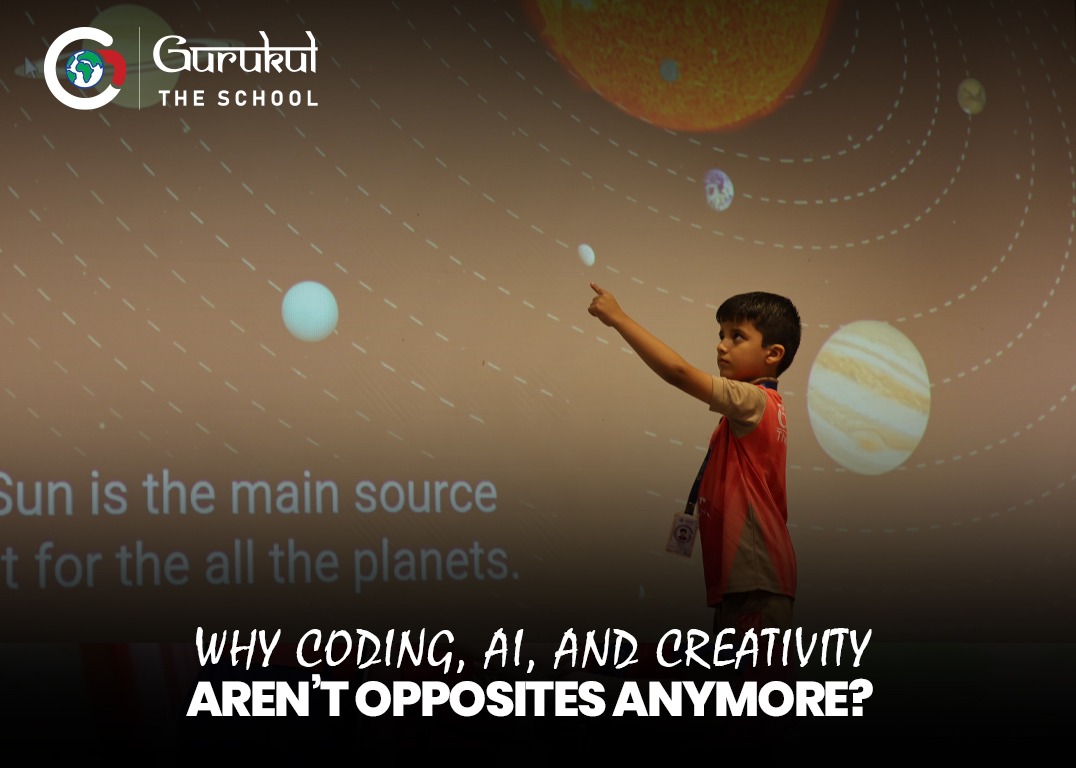Why Coding, AI, and Creativity Aren’t Opposites Anymore?
posted on Jun 19, 2025
Gurukul The School, one of the top schools in ghaziabad, would like to assure you that instances like these perfectly capture today’s reality.

How would you respond if you see your kids sitting at their computer, not browsing social media or playing games, but creating digital art using AI tools and then coding an interactive website to display their digital art? While it can surprise many parents, scenarios like these aren’t uncommon in today’s tech-driven world. We at Gurukul The School, one of the top schools in ghaziabad, would like to assure you that instances like these perfectly capture today’s reality.
For decades, we’ve been told that people are either left-brained (logical, mathematical) or right-brained (creative, artistic) and that coding strictly belongs to the technical side while creativity lives in the arts stream. However, the shared example demonstrates that it is merely outdated thinking. People no longer need to choose between being creative or being good at technology as they’re interconnected aspects, not opposites.
Since many people still view coding, AI, and creativity as entirely different aspects, we’ve created this blog post to highlight how they aren’t opposites anymore. Read the full blog to gain further clarity.
The Creative Side of Coding
The idea that coding is purely logical and uncreative is one of the biggest misconceptions of our time. We at Gurukul The School firmly believe that programming/coding is fundamentally about creative problem-solving and requires the same kind of innovative thinking that artists use when deciding how to express an emotion or interior designers use when figuring out how to make a space both beautiful and functional.
For example, when web developers create user experiences, they’re not just writing lines of code but crafting digital environments that feel intuitive and engaging. Every coding decision involves aesthetic and functional choices, such as which colour scheme will make users feel welcome, what kind of animation will hold viewers’ attention, and more.
All of it requires a healthy combination of creativity and technical prowess. Hence, when students learn to code, they use their creative thinking muscles as it helps them break complex problems into manageable parts and enables them to think systematically about solutions. Essentially, coding develops logical reasoning and creative problem-solving in kids, making them well-rounded thinkers.
Artificial Intelligence (AI) as a Creative Partner, Not a Replacement
One of the biggest fears spread around AI is that it will replace human creativity, replacing musicians, artists, writers, etc. While the fear is understandable, we at Gurukul The School feel it’s misplaced because it stems from a fundamental misunderstanding of what AI actually does and how creativity works.
AI doesn’t replace human creativity but amplifies it, much like how digital music software didn’t eliminate musicians but gave them newer ways to compose and perform. Today’s creative professionals combine technical knowledge with their creative side to create masterpieces rather than viewing them as opposite forces.
For instance, musicians use AI to generate melodic ideas and then apply their own artistic vision, personal expressions, and emotional intelligence to develop these melodies into full songs. Similarly, anyone can use AI to express their creative ideas through digital creation, making AI and creativity an unbeatable collaborative partner.
Real-World Examples of How Coding, Creativity, and AI Aren’t Opposites Anymore
If you think the convergence of coding, creativity, and AI is limited to theoretical explanations and concepts, you must explore how individuals and corporations are using them together. Film studios like Pixar and Disney use AI and sophisticated coding to create stunning visual effects and lifelike animations that make movies look magical.
However, they don’t simply use coding and AI in their filmmaking process. Their teams combine this technology with the director’s creative vision, the writers’ storytelling skills, and the animators’ artistic talents to create phenomenal masterpieces. Even architects use computational design tools to explore building possibilities that would have otherwise been impossible to visualise a few years ago.
Architects combine these AI tools with their creative vision to design spaces that aren’t just structurally sound but also beautiful, functional, and meaningful to people who live there. You can find endless examples like these where almost every professional and organisation is combines coding, AI, and creativity to refine their work quality, processes, and end results. All this signals good news — you no longer need to pick a side and embrace technology and creativity as one.
Conclusion
When AI didn’t exist, it was easy for people to label creativity and technical knowledge like coding as opposing forces, but AI has blurred all previous distinction lines. Today, all three elements (Creativity, Coding, and AI) have become collaborative partners, each amplifying the power of the other to create solutions, experiences, and expressions that neither could have achieved alone.
This is the reason why we at Gurukul The School, ranked among the top 5 CBSE schools in Ghaziabad, always encourage our students to stay curious about both technical and creative pursuits instead of choosing one. We believe today’s children should try to identify and learn skills in both areas as it can make them more capable, more adaptable, and more able to contribute meaningfully to whatever field they choose. The most exciting future innovations will emerge at the crossroads of human creativity and technological capability, so act accordingly.